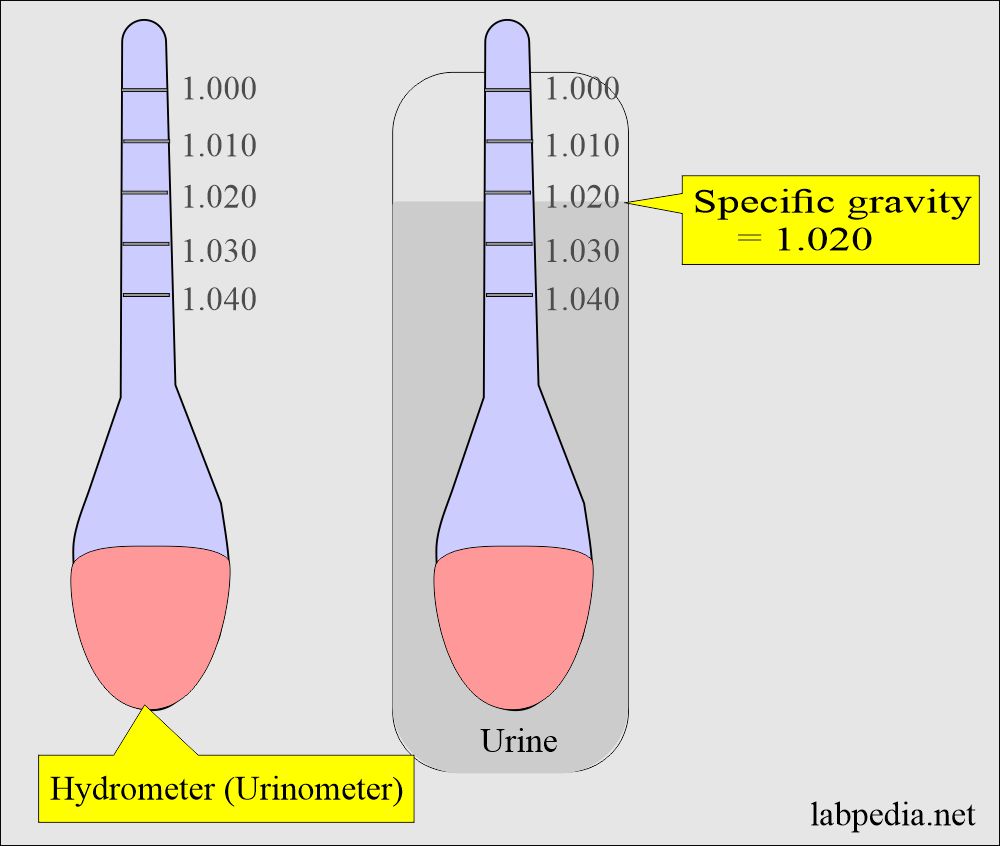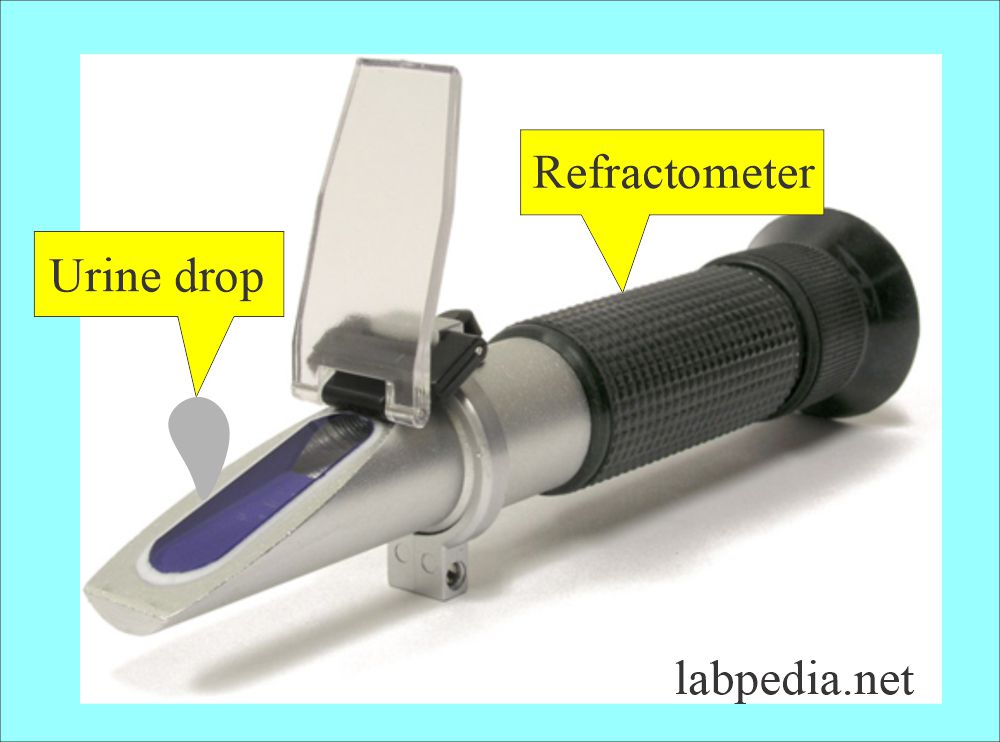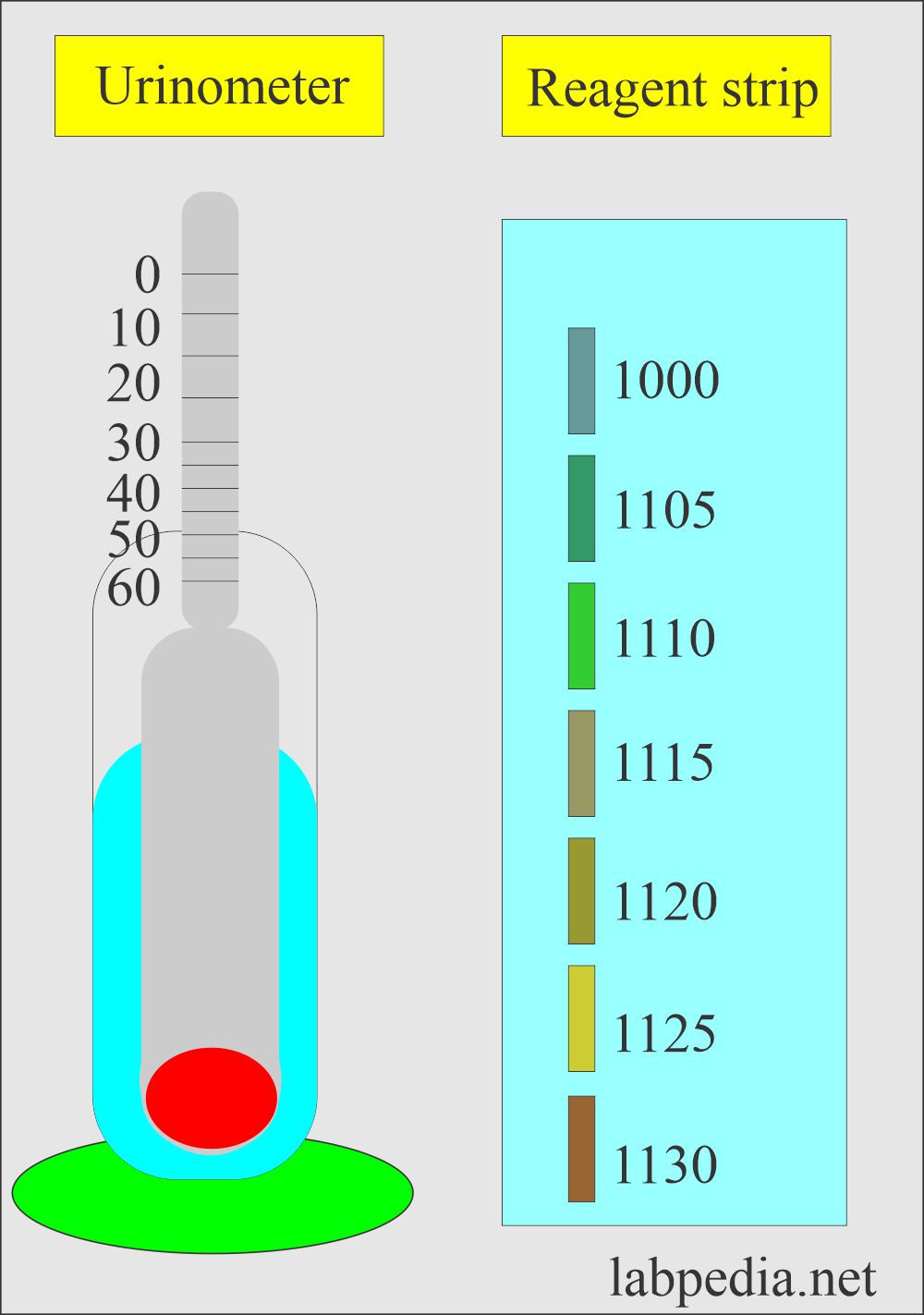Urine Specific Gravity and Its Significance
Urine Specific Gravity
What sample is needed for urine-specific gravity?
- A random urine sample can be taken.
What are the indications for Urine Specific Gravity?
- Urine analysis is part of the routine diagnostic profile.
- This gives an idea about kidney function.
- This also gives an idea about the hydration status.
What are the precautions for Urine Specific Gravity?
- Urine collected after the I/V administration of iodine-containing radiopaque material gives high values of specific gravity.
- Glucose and the protein in the urine also have a high value.
- Diabetic patient with hyperglycemia gives high value.
- Patients with contrast radiography and dextran infusion may have high specific gravity.
- Temperature also has an effect on specific gravity, as it increases in the cold.
- In the case of detergent in, the container may give high specific gravity.
- Diuretics and antibiotics give rise to high specific gravity.
How will you define urine-specific gravity?
- Urine-specific gravity is the measure of the kidney’s ability to concentrate urine.
- The important process of reabsorption by the kidneys is often the first renal function to become impaired.
What are the facts about urine-specific gravity?
- So, the specific gravity will detect dehydration or abnormality in the antidiuretic hormone.
- Urine is a solution of minerals, salts, and other compounds dissolved in water.
- Specific gravity = water + dissolved chemicals.
- So, specific gravity measures the density of dissolved substances in the urine.
- Specific gravity is the weight of urine compared to distilled water, which has a specific gravity of 1.000.
- The specific gravity of the plasma entering the glomerulus is 1.010.
What are the types of urine according to the specific gravity?
Isosthenuria
- The urine-specific gravity is fixed and remains constant at around 1.010.
- It is not influenced by water intake or dehydration.
- Normal kidneys concentrate the urine in dehydration.
- It is the urine that has no greater or less than the protein-free plasma specific gravity.
- It is urine with a specific gravity of 1.010 (1.008 to 1.012).
- It suggests renal damage.
- These patients need medical check-ups and workups.
Hyposthenuria
- Specific gravity is low = <1.010 (1.001 to 1.010).
- It occurs in the following conditions:
- Diabetes inspidus. This is due to the absence or decrease of ADH. Without ADH, the kidneys produce excessive urine that is not reabsorbed.
- Glomerulonephritis and pyelonephritis. Specific gravity is low with decreased urine volume.
- Severe renal damage. There is a disturbance in both concentrating and diluting abilities of urine.
Hyperstheuria
- Increased specific gravity is > 1.010 (1.025 to 1.035).
- It is seen in the following conditions:
- Diabetes mellitus.
- Nephrosis.
- Increased secretion of ADH.
- The diuretic effect of stress of the surgical procedure.
- Excessive water loss due to dehydration, fever, diarrhea, and vomiting.
- Toxemia of pregnancy.
- Cardiac diseases like congestive heart failure.
What factors define urine-specific gravity?
- The state of hydration.
- Urine volume.
- High specific gravity indicates concentrated urine.
- Low specific gravity indicates dilute urine.
- The reflectometer can read specific gravity.
What is the normal urine specific gravity?
- Random sample = 1.003 to 1.035.
- Most random sample = 1.015 to 1.025.
- A specific gravity of 1.023 or higher is generally considered normal.
- Specific gravity >1.035 is usually seen in the renal pyelogram (IVP).
- Specific gravity <1.003 is not urine.
Source 2
| Age | Specific gravity |
|
|
|
|
|
|
|
|
|
|
How will you diagnose the specific gravity of urine?
The Hydrometer:
- It checks the specific gravity but needs an abundant quantity of urine.
- The urine-specific gravity can be measured by a few drops of urine with the help of a refractometer.
Absorbent cellulose strip:
- These are impregnated with bromthymol blue, polymethyl vinyl ether, and or maleic anhydride and sodium hydroxide.
-
- The color changes to dark blue at a low specific gravity of 1.000.
- Yellow-green at a specific gravity of 1.030.
Machine-readable devices:
- These are available from the Clinitek system, Bayer Diagnostics, and Elkhart Ind.
-
- If the urinometer does not measure the specific gravity, dilute urine 1:2.
- Now multiply the reading by 2.
What are the causes of increased urine-specific gravity?
- Dehydration.
- Decreased renal blood flow.
- Diabetes mellitus.
- Excessive water loss in fever, vomiting, and diarrhea.
- Toxemia of pregnancy.
- Congestive heart failure.
- Proteinuria.
- Water restriction.
What are the causes of decreased urine specific gravity?
- Diabetes insipidus.
- Early chronic failure.
- Severe renal damage.
- Hypertension.
- Overhydration.
- Diuresis.
Questions and answers:
Question 1: Is Isosthenuria abnormal?
Question 2: What is the specific gravity of concentrated urine?




really this site is very helpfull to us.We salute you.
Thanks a lot for the encouraging comments.
I am 45 I have HIV-1 and 3 artist deseas and a super high amun system. This is the worst wired thing in the world. My clinic told me that my test are good but something odd my specific gravity is 1.023 my body has the ability to reject any foren harm and what my body doing to pop and I change the way I drink water because that straight make me see light head foggy stuff. I done away with to much sugar and watch water I eaten and my urine is close to distilled water and I see what is says here. I know I have rare blood it says a lot of wired stuff in my DNA on.medicine and ancestry. So my mind can’t make any sense of all this.
How much volume of urine is needed?
It depends upon the procedure; if you are using strips, few drops of the urine are enough. If you use a specific gravity meter (urinometer or hydrometer), then at least 10 mL of the urine is needed.
Hello Doc. I’m 23 years old, male is the result of my urinalysis okay?
Color: Light Yellow
Transparency: Slightly Turbid
pH: 6.0
Specific gravity: 1.005
Sugar:Negative
Protein: Negative
RBCs: None
PUS cells: 0.2/hpf
Squamos Ephitelial Cells: Rare
Mucus Threads: Moderate